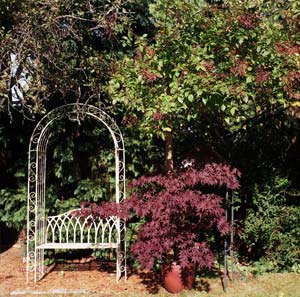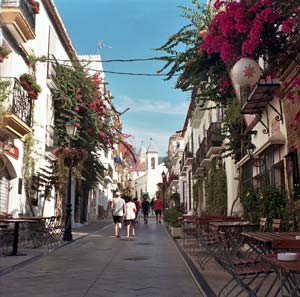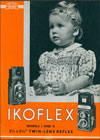Zeiss Ikon Ikoflex I
Specification
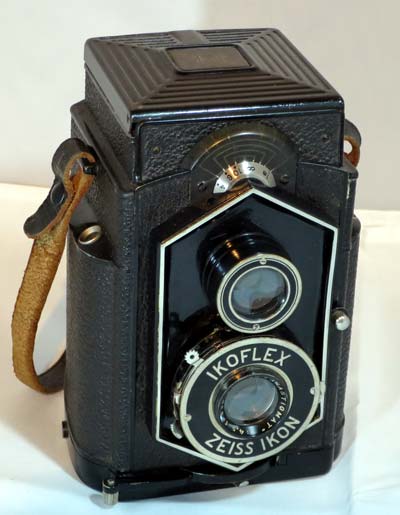
| Manufacturer | : | Zeiss Ikon |
|---|---|---|
| Produced | : | 1934 |
| Classification | : | Medium Format |
| Body Type | : | Twin Lens Reflex |
| Construction | : | Metal |
| Film Type | : | 120/620 |
| Film Width | : | 62mm |
| Image Size | : | 6 x 6 cm |
| No. of Images | : | 12 |
| Lens Type | : | Novar Anastigmat |
| Focal Length | : | 80mm |
| Focus Type | : | Variable |
| Focal Range | : | 3.6ft - inf. |
| Aperture Type | : | Iris |
| Apertures | : | f/4.5 - f/22 |
| Shutter Type | : | Self-cocking leaf |
| Shutter Speeds | : | T, B, I(1/100s, 1/50s, 1/25s) |
| Size Viewfinder Open (w x h x d) | : | 95 x 198 x 95 mm |
| Size Viewfinder Closed (w x h x d) | : | 95 x 140 x 95 mm |
| Weight | : | 1070g |
Art Deco Credentials
![]()
![]()
![]()
![]()
![]()
Iconic: Famous, well-known and celebrated
I consider this camera to warrant 5 stars for the following attributes:
- produced during the main Art Deco period
- hexagonal shutter plate
- shutter plate in chrome and black enamel
- body has stepped design
- viewfinder cover has stepped design
- chrome embellishments
- decorative concentric circles on lens plate
- decorative concentric circles around viewfinder lens
Description
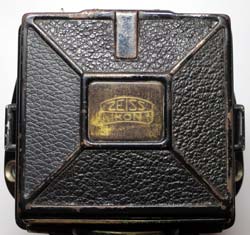
This was the very first Ikoflex, originally launched in 1934 as the Ikoflex I, and sold until April of the following year. It has been given the nickname 'Coffee Can' because the Art Deco styling was said to look like German WW1 trench coffee can. It is distinguished by the shallow "Mexican pyramid" style of the viewfinder cover. The pyramid cover was replaced with a quadrant design, with the quadrants covered with the same leather as the body. This version is much more common than the pyramid style. The body is all black emamel on a cast magnesium body. The unusual feature of this camera is that the film travels horizontally, with the wind lever below the object lens. It has a depth of field calculator above the viewfinder.
How to Use
The film is loaded by pressing a button on the back and dropping down the bottom of the camera to reveal the spools. Once loaded, the film is advanced until the no.1 appears in the red window. This red window can now be closed and is no longer needed. A lever below the film advance is now pressed and the two frame indicators are returned to the start (number 1). One of the frame indicators (marked 'Met') should only be used if thin 620 metal spools are used. With plastic or wooden 120 spools the other frame indicator is used. You should get 12 images.
A lever on the side of the lens plate is used to focus the camera.
Shutter speeds are 1/25s, 1/50s and 1/100s although the accuracy is not guaranteed.
If you don't want to bother with an exposure meter, follow the guide shown. It is based on the 'Sunny 16' rule. Film is so forgiving and will produce acceptable results even when overexposed by 2 or 3 stops or underexposed by 1 stop.
Remember that the exposure guide that is found on the camera may not be helpful as it is based on the use of old film with a low ISO value.
The tables assume that the sun is at least 30 degrees above the horizon - that's 10am - 5pm on a summer's day in the UK.
If you are not sure about the light level, err on the side of overexposure - i.e. assume the smaller f number.
Where there is a choice, a larger f number will give a larger depth of field.
For the slower speeds, you may need a tripod to stop blur through shake.
Using ISO 100/125 film
| Weather Conditions | Shadow Detail | Shutter Speed (s) | ||
|---|---|---|---|---|
| 1/25 | 1/50 | 1/100 | ||
 Sunny SunnySnow/Sand | Dark with sharp edges | - | - | f/22 |
 Sunny Sunny | Distinct | - | f/22 | f/16 |
 Slight Overcast Slight Overcast | Soft around edges | f/22 | f/16 | f/11 |
 Overcast Overcast | Barely visible | f/16 | f/11 | f/8 |
 Heavy Overcast Heavy Overcast | None | f/11 | f/8 | f/5.6 |
 Open Shade Open Shade/Sunset | None | f/8 | f/5.6 | f/4.5 |
Photographs taken with this Camera
Using Portra 160 120 film.

